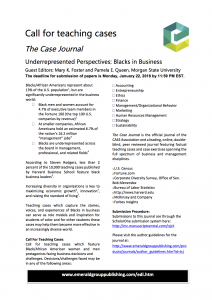
I’d like to share with you a recently published Letter from the Editor that provides further rationale and hopefully motivation for contributors to TCJ’s Special Issue on Underrepresented Minorities. R. Morris
The full citation is here:
Rebecca J. Morris, (2017) “Underrepresented minority protagonists: an impactful opportunity”, The CASE Journal, Vol. 13 Issue: 5, pp.589-59.
Underrepresented minority protagonists: an impactful opportunity
In 2015, the White House Council of Economic Advisors and more than 150 deans and leaders of business schools met to discuss a report prescribing “Best Practices” (AACSB, 2015) for business schools in preparing students to meet the needs of the twenty-first century workforce. The report focused on a workforce that was becoming increasingly more diverse in terms of both gender and ethnicity. Report recommendations dealt with four areas:
- ensuring access to business schools and careers;
- building a business school experience that prepared students for the workforce of the future;
- ensuring career services that met the needs of non-traditional students; and
- modeling best practices of effective organizations.
The Association to Advance Collegiate Schools of Business (AACSB) has made the report the focus of its commitment to diversity and inclusion since that time, expanding the focus of programs beyond gender equity and parity to include other dimensions of diversity and inclusion such as ethnicity, culture and global region.
In a week where the firing of a Google software engineer for “advancing harmful gender stereotypes” (Wakabayashi, 2017) and the violent clash of white nationalists and counterprotestors in Charlottesville, Virginia (Astor et al., 2017) were widely covered in the news, an appreciation of diversity and inclusion issues seem ever more timely and critical. As educators, incidents such as these become teachable moments – where educators recognize the responsibility to prepare students to lead in a workplace with changing demographics. As creators of educational content, case writers have an opportunity to make a strong impact on student understanding of diversity and inclusion issues.
Diversity, inclusion and case writing
The “Best Practices” report addressed case studies specifically in its recommendations. Case writers were urged to make:
Case studies more representative and [ensure] that they reflect modern workplaces. For example, showing diversity in leaders solving a wide range of problems is important to illustrate the wide range of diversity in the business community. This includes showing women and minorities in more significant line management roles and/or as the main protagonist in the case (AACSB, 2015).
In case writing and research, selecting an appropriate protagonist is an important choice that ultimately determines whether students are inclined to engage in solving the case problem. As one experienced case writer explained it, “Readers of cases don’t care about situations, theories or problems. They care about people. The reader must feel empathy for […] the case character in order to participate in helping that character to solve case problems” (Vega, 2017).
Unfortunately, the majority of published cases feature white male protagonists, providing a view of the world that omits contributions of women or minorities. An article published in the Harvard Business Review (Symons, 2016) revealed that only one case of 21 award-winning cases from 2015 to 2016 featured a female protagonist. Only two of the approximately 300 cases read by first-year MBA students at the Harvard Business School featured a black protagonist (Fernandes, 2017). Although these two studies did not analyze all possible case studies, it seems clear that the case catalogue is not consistent with the “Best Practices” report. Women and minority protagonists are underrepresented in the case literature.
Forthcoming special issue of TCJ: underrepresented perspectives
One solution to this diversity gap is to encourage case writers to write cases that feature women and underrepresented minority protagonists. At TCJ, a special issue has been established to address the lack of teaching cases that feature black/African-American women and men protagonists. Mary K. Foster and Pamela E. Queen of Morgan State University, Baltimore, Maryland will serve as the Guest Editors for this special issue. In their call for cases, Foster and Queen explain the rationale for cases featuring underrepresented perspectives saying:
Teaching cases which capture the stories, voices, and experiences of Blacks in business can serve as role models and inspiration for students of color and for other students these cases may help them become more effective in an increasingly diverse world.
Cases submitted for the special issue must feature “Black/African-American women and men protagonists facing business decisions and challenges.” The decisions or challenges addressed by the case may be in any business discipline. The deadline for submission of cases is Monday, January 22, 2018. The full call for cases can be obtained by e-mailing Mary Foster at: [email protected], Pamela Queen at: [email protected] or the TCJ editor at: [email protected]. (NOTE: THE CALL CAN BE FOUND BELOW).
Countless studies can be found identifying the business benefits of diversity and inclusion, yet our case catalogue provides few representations of successful women and minority business executives. TCJ encourages submissions of cases for the special issue to help prepare future leaders for a workplace that is more inclusive and more collaborative. Now is the perfect time for case writers to provide much needed teachable moments.
References
AACSB (2015), “Best practices for business schools to lead in expanding opportunity for women in business and to adapt to the 21st century workforce”, AACSB.edu/Diversity, AACSB, Tampa, FL, August 5, p. 2, available at: www.aacsb.edu/-/media/aacsb/docs/diversity/business-school-best-practices.ashx (accessed August 15, 2017).
Astor, M., Caron, C. and Victor, D. (2017), “A guide to the Charlottesville Aftermath”, The New York Times, August 13, available at: https://nyti.ms/2vvL7MW (accessed August 15, 2017).
Fernandes, D. (2017), “Harvard business school makes a case for diversity”, The Boston Globe, February 11, available at: www.bostonglobe.com/business/2017/02/10/harvard-business-school-makes-case-for- diversity/vSkHnIj35zXBU7ijIM7OCL/story.html (accessed August 15, 2017).
Symons, L. (2016), “Only 11% of top business school case studies have a female protagonist”, Harvard Business Review, March 9, available at: https://hbr.org/2016/03/only-11-of-top-business-school-case- studies-have-a-female-protagonist? (accessed August 18, 2017).
Vega, G. (2017), The Case Writing Workbook: A Self-Guided Workshop, 2nd ed., Routledge, Taylor & Francis Group, New York, NY, p. 61.
Wakabayashi, D. (2017), “Contentious memo ripples beyond Google”, The New York Times, August 9, p. B1.


